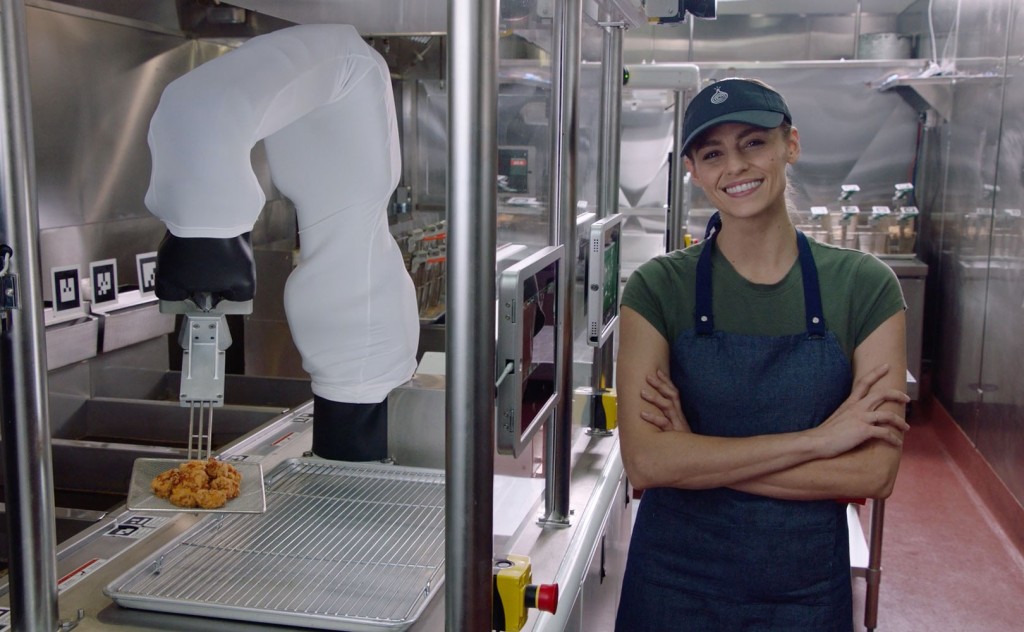How “Cobots” Are Transforming Jobs in Every Industry, from Fast Food to Law
CaliBurger does not intend for its restaurants to be entirely staffed by robots. As its website details, Flippy allows employees to spend more time helping customers, rather than sweating over the hot grill.
“This is a cobotic working arrangement, where we have the robot automating certain tasks that the humans don’t necessarily like to do,” John explains. “But we still need people in the kitchen managing the robotics systems and working side by side with the robot to do things that it’s not possible to automate at this time.”
As robots like Flippy become commonplace, helping new and existing employees adjust to the working arrangements will be essential. Companies can help employees understand that these tools exist to make them more productive and take some less enjoyable tasks off their plate, and invest in training to ensure they feel comfortable working with the tech. This may be their first time working alongside a robot, so taking steps to smooth the transition will help them feel confident and supported.
“It’s something different,” one CaliBurger employee says. “It takes a little bit of getting used to, but I really do like it.”
High-skill jobs are not immune to automation — even law, medicine, and finance roles will look very different in 10 years
While there’s been a lot of talk around how automation will impact blue-collar workers, less has been said about white-collar roles. The truth is, advances in artificial intelligence (AI) have made these machines capable of handling complex tasks, and no industry is immune.
“One virtue of technology is that it’s impersonal,” says Krishna. “It’s an equal opportunity disruptor. So even as automation and AI hit lower-wage jobs, they’re coming for higher-wage jobs too. With vast amounts of data available in the legal, medical, and financial world, and the tools to shove it all into the computer, the machines are coming.”
In the law sector, McKinsey estimates that today, 22% of a lawyer’s job and 35% of a paralegal’s can already be automated. One task that’s ripe for automation is the tedious process of reviewing and approving contracts, as legal tech company Lawgeex is proving.
Lawgeex fed tens of thousands of contracts into an AI engine to train it in contract law. The system can review a contract, flag anything that doesn’t meet company policy, and provide guidelines about how employees can fix it. It’s more than just a fancy spellchecker — the AI can grasp the meaning behind words in the same way that a human lawyer would.
“The only difference is that with the AI system, it never forgets, it doesn’t get tired, and it doesn’t need to drink coffee,” says Noory Bechor, Lawgeex’s CEO.
The system is not only faster than its human counterparts, but more accurate too. Going head to head with Tunji Williams, a lawyer from the University of Virginia Law School, the machine achieved a 95% accuracy rate on the two NDAs it reviewed. The lawyer scored 83% and 85% for the same NDAs, missed one critical mistake, and took more than twice the time. Surprisingly, though, he wasn’t worried about what this could mean for his job.
“I wasn’t disappointed when the iPhone came out,” Tunji says. “I can do more things with this new piece of technology, so this is exciting to me.”
Noory acknowledges that the Lawgeex system couldn’t pass the bar exam (at least, not yet), so if your company employs lawyers, don’t expect to stop needing them altogether. They’ll just be focusing on more interesting, complex tasks while leaving the rote work to the machines.
“You have a new generation of lawyers who are much more tech-savvy,” Noory says. “The ones that can actually leverage technology are the ones that manage to prosper.”
To make cobotics truly collaborative and beneficial to employees, companies need to focus on making work meaningful and reskilling accessible
Cobotics is not without its drawbacks. For one thing, while automation tends to actually create more jobs than it wipes out and increase salaries overall, many displaced workers will need to undergo retraining to find a new role. And for many, realistic opportunities to retrain are few and far between.
“Depending on your personal circumstances, [retraining] could be very hard,” says Landon Cofer, a team member working on assembly and conveyance at Toyota. “If you work a full shift and you have a family, you may only have an hour or two of free time a day. Are you supposed to go drive to the training facility and spend a few hours a day there before you go work your shift? I don’t think very many people would do that.”
When employees are forced to do more work just to keep up, it’s easy to become demoralized and disengaged. That’s why it’s vital that companies help their employees transition into new roles seamlessly by providing on-the-job learning opportunities. By making retraining part of employees’ regular work, rather than something they do unpaid in their own time, companies can ensure they have the necessary skills under their roof for the future — and win the loyalty of their workforces.
Another key consideration is how to make work feel meaningful and, well, human. Focusing too much on the efficiency gains brought about by robotics can leave employees feeling like one of the machines themselves.
This is an issue that Amazon is currently facing at its robotic-enabled fulfillment centers. While the company’s technologists are excited about creating a better system in which humans and machines work together in harmony, some employees feel that their jobs are becoming more impersonal.
“I haven’t been put in a position where I can be creative,” one associate says. “Being useful, that’s part of being human. We all have to feel useful for something.”
Helping employees find a sense of meaning and purpose in their work is only going to become more important as they start work alongside robots on a daily basis. Showing them the impact their work is having on society or individual customers is one way to do this, creating a personal, emotional connection that can’t be replicated by a machine.
Opportunities to be creative and solve problems can also go a long way toward making work feel more varied and exciting, as can a unique company culture. The goal is to avoid every day feeling the same, since this can cause employees to feel like they’re just another cog in the machine.
During the rise of machines, the secret weapon will be listening
One of the most important lessons in HBO Vice’s report was revealed by Chuck Price, vice president of product at TuSimple, a self-driving truck company. With self-driving cars and trucks already being piloted on real roads, the trucking industry is especially vulnerable to disruption right now. But when asked what he tells truck drivers about this, Chuck had an interesting answer.
“We try not to tell truckers things,” he says. “We try to listen.”
Employees might be feeling anxious about what AI and automation mean for their future. As a result, the best thing employers may be able to do for their workers is to listen to their concerns and educate them about automation. Assuring them that their job is secure is less meaningful than helping them understand how their role might evolve and outlining any resources that can help keep their skill set relevant.
“We’re kidding ourselves if we think things are not going to change,” Noory says. “But similar to pilots, with the autopilot, it’s not like we don’t need pilots anymore.”
To receive blog posts like this one straight in your inbox, subscribe to the blog newsletter.
* Photo from Miso Robotics
Related articles




